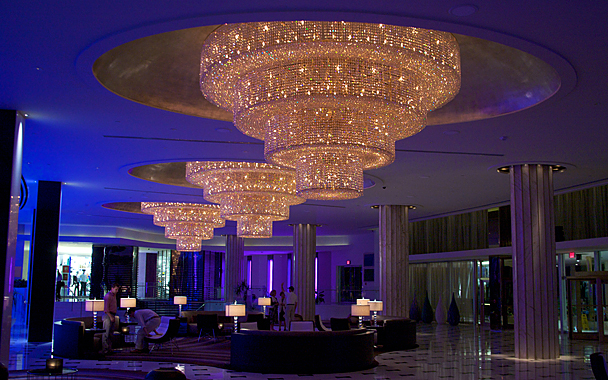When I first caught South Beach fever back in the early ‘90s, I bought an irresistibly sexy condo whose neon “Flamingo Plaza” sign sent rays of pink through the Art Deco windows of my bedroom. Ocean Drive was off-the-wall crazy, a mix of retirees from the few remaining nursing homes that once lined the beach (a strip known as God’s Waiting Room), tall models, gay guys, Euro families whose kids were as chic as the adults, and the occasional Hassidic family strolling in front of the outdoor cafés sprouting along the sidewalk. Every now and then, the cops would bust into to one of the newly restored Deco gems for an old-fashioned drug bust—after Art Deco and old people, drugs were the area’s most famous claim to fame.
A year later, everything had changed: It was all hip, all the time on South Beach. Gone were the old-folks homes, every last one converted into hotels or condos. The seriously uncool part of Miami Beach was up by the Fontainebleau, the classic ‘50s “horror” that had once enjoyed such a prominent place in the sun, not to mention a starring role in the movie Goldfinger.
How times change. Ocean Drive today is permanently stuck on spring break—not so much a time warp as a seasonal one. The scene moved some years ago, up around Lincoln Road, after the Delano opened in 1995. And now it’s leaped again—some 20 blocks farther north—back to the Fontainebleau, suddenly a revered classic whose architect, Morris Lapidus, is spoken about in hushed tones. The famously gaudy chandeliers, big enough to be planets, have never shined brighter. (It’s amazing what a $1 billion makeover can do.) For me, though, it was déjà vu all over again.
When I checked into the Fontainebleau the other day, there was all the glorious flora and fauna, just as I’d remembered. The Europeans and gay couples, the tanned South Americans and skinny models had all come home to roost. Over by the bar, two guys bounced around in cut-offs—only in cut-offs, no shirts, no shoes. There weren’t many oldsters hanging out on the retro chairs, but I was almost mowed down by a flank of badge-toting conventioneers streaming toward a distant buffet table. (A few Polyester People always found their way to South Beach in the old days, too.) The next morning, as I came down for breakfast, clubbers were drifting out of LIV, the Fontainebleau’s own nightspot. As if not to be left out of this beachside Noah’s Ark, the Hassidic couple finally appeared, pushing a baby carriage.
The Fontainebleau has brought Las Vegas to South Beach: The 37-story, four-building compound is no longer just a flashy hotel for New Yorkers but a mega resort worthy of the Strip (P.S., a branch of the Fontainebleau actually is scheduled to open in Vegas later this year). And just like the destination monoliths out West, the Fontainebleau Miami Beach now comes with star-chef restaurants. As I dined at Scott Conant’s Scarpetta (a branch of the restaurant in New York’s Meatpacking district), I savored the wonderful (and simple) spaghetti with tomatoes and basil for which he is famous, the same mushrooms and polenta, and an incredibly flavorful Stromboli bread baked with smoked mozzarella, sopresatta, and basil. (The hotel also has a branch of New York’s Gotham Bar And Grill, from Alfred Portale.) On Sunday Hakkasan, from London restaurateur Alan Yau, opens on the roof of the hotel’s new spa and gym, a black box of reflective glass that looks like a meteorite that happened to land next to the toothpaste-white hotel.
It all struck me as impossibly insane. And awfully familiar.




 Pinterest
Pinterest


